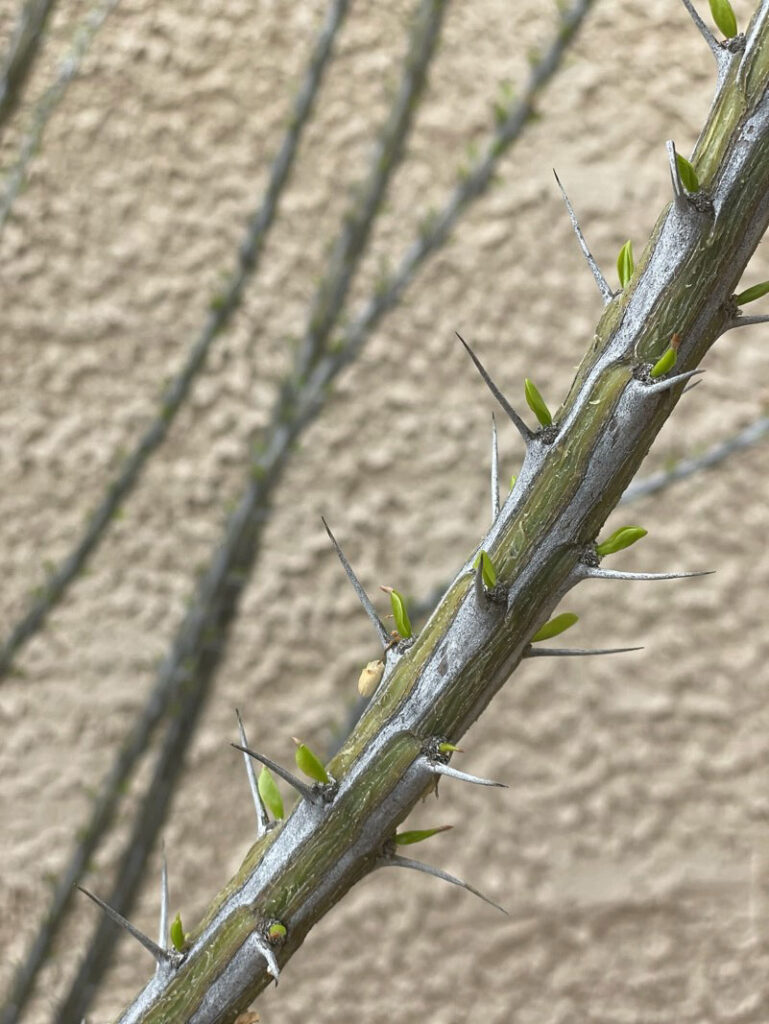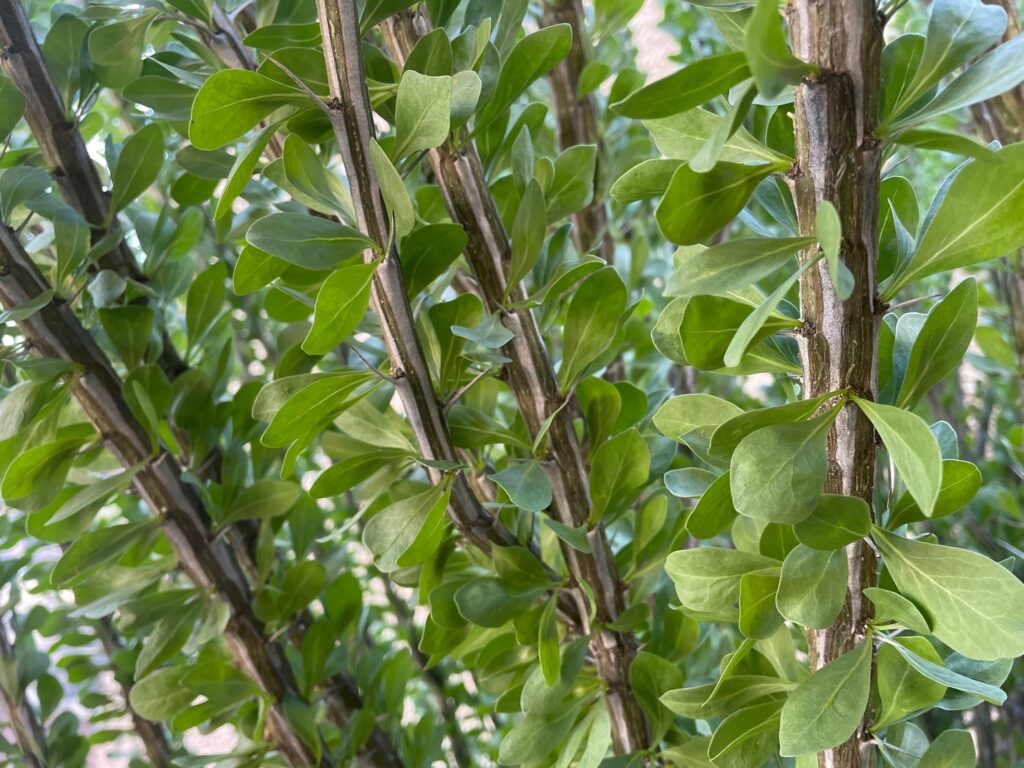
We’ve recently had quite a bit of rain in the Phoenix and Anthem areas. Many drought-deciduous trees and plants are thriving after surviving the ongoing drought conditions.
But, even with the added moisture, some plants and trees that you thought were surviving might not be bouncing back, including some ocotillos.
In this article, we’ll cover:
- what an ocotillo plant is (and is not!),
- some interesting facts about ocotillos (including what you cannot do with them),
- how to tell if your ocotillo is dead or just dormant, and
- an interesting way that ocotillos have been used in landscapes for centuries.

What is an Ocotillo?
Ocotillo, or Fouquieria splendens, is a desert plant that often looks like a bundle of dead sticks. It goes by many names, including:
- Coachwhip
- Candlewood
- Slimwood
- Desert coral
- Jacob’s staff
- Jacob cactus
- Vine cactus
- Flaming sword
- Devil’s walking stick
- Monkey-tail
However, most people use the common name of “ocotillo,” which is Spanish for “little torch.” This name makes sense when the bright orangish-red flowers appear at the tips of the ocotillos every spring.
Despite being a desert plant (and often leafless), ocotillos are not a type of cactus. In fact, they are more closely related to blueberries and tea than to a saguaro.
Growing Ocotillo in the Home Landscape
Ocotillos grow 16-20 feet tall with a spread of 11-15 feet. They can grow in rocky soils and caliche, but don’t do well in areas with poor (or slow) drainage.
They have a taproot that can reach deep into the ground, as well as some lateral roots. This tap root and the waxy surface of the plant help it to obtain and conserve moisture during periods of drought.
Ocotillos can be planted any time of year, but they do require full sun.
Ocotillos are estimated to live up to 60 years, though some have been found that are closer to 100 years old!
While wildflowers blossoms are dependent on winter rains, ocotillos bloom every year, usually between February and April.

Ocotillos are Protected
Ocotillos are listed as “salvage restricted native plants” under the Arizona Native Plant Law. This means that they cannot be harvested from the desert (or anywhere else that you see one).
For more details, read more about Arizona’s Native Plant Law or visit the Arizona Department of Agriculture website for even more information.

Is My Ocotillo Dead?
For most of the year, ocotillo plants look like long, spiky sticks. After some rainfall (or irrigation), the sticks grow small, dark green leaves, covering the plant and transforming how it looks. The leaves grow for 2-3 weeks and then fall off when the soil dries out.
Because they are drought-deciduous, ocotillos can appear lifeless for most of the year. This is especially true if there hasn’t been a lot of rain (such as during the “non-soon” season in 2020). Once there is adequate moisture, a healthy ocotillo will begin sprouting leaves.
This cycle can happen up to 4 or 5 times a year, depending on the weather, rainfall, and irrigation.

Therefore, if there has been significant rainfall and your ocotillo hasn’t produced any leaves – especially if you notice that others in the area have – your ocotillo might not have survived.
Keep in mind, however, that if your ocotillo was recently planted, it may not have enough energy yet to produce leaves. Its priority is to create a root system. Second on the list is to create flowers. So, an ocotillo may not leaf out for the entire first year after it is planted.
After that, the leaves may not fully develop until the ocotillo knows it has the water and energy it needs to fully support leaf growth.
How to Tell if an Ocotillo is Dead or Alive
It can be difficult to know if your ocotillo is dead or just dormant. Here are four ways to determine if your ocotillo is still alive:
- Check if the branches (or canes) are flexible. If you can bend them without breaking, your ocotillo is still alive.
- Ocotillos contain green pigment on the stems, which helps them create energy via photosynthesis even when they don’t have leaves. You can check for this green pigment by wetting a stem. If the plant is alive, you should see green bands of chlorophyll running through the branches.
- Look above each spine for leaf buds. They will be very small but should be visible (they might even be green). Leaf buds are most likely to appear in spring but might also show up in the summer and fall.
- If it’s not a rainy period and you really want to know the status of an ocotillo, you can water it yourself and see if there are any changes in the next few days. Remember to water slowly and deeply, just as you would for a tree. You can use a garden hose and create a slow trickle of water, keeping the area around the plant watered for two or more days. If you start to see leaves appear, you know that your ocotillo is still alive. Keep in mind, however, that even ocotillos in well-irrigated landscapes will lose their leaves several times a year.

Ocotillos and Pollinators
Ocotillo flowers are an important source of nectar for various pollinators, including hummingbirds and carpenter bees. Hummingbirds, in particular, love the ocotillo flowers as they are the perfect tubular shape for the birds to reach the nectar.
Interestingly, ocotillos tend to bloom just as hummingbirds are migrating northward in Arizona. Therefore, they become an even more important source of food, especially during years where other spring flowers (such as wildflowers) are scarce.

Image courtesy of Leslie Seaton from Seattle, WA, USA – Ocotillo fencing, CC BY 2.0, https://commons.wikimedia.org/w/index.php?curid=33881127
Ocotillo Fences
If you don’t have room for a traditional ocotillo, or if you’re looking for a unique way to block off a section of your yard, you might want to consider an ocotillo fence. Thanks to the spines that cover the branches, ocotillo fences are a functional way to block off an area – or even to add some extra interest.
Ocotillo fences have been in use for generations and are not hard to make. You can watch this 5-minute tutorial from Mission Garden to make your own fence panels. Alternatively, several Arizona nurseries sell pre-made ocotillo panels. Keep in mind, however, that ocotillos are protected. That means you can’t go into the desert and harvest the branches for your use.
If the fence is planted and watered soon after the branches are harvested, the ocotillo fence can become a “living fence,” growing and producing leaves after rainfall just like a regular ocotillo plant.
Ocotillo branches can also be used to create a roof on a pergola or other outdoor structure for dappled shade.

In Summary
Our desert plants and trees are amazing and well-adapted to the unique climate and weather patterns of the Phoenix and Anthem areas. Ocotillos are a great example of that, conserving their energy and water during times of drought and producing beautiful foliage after enough rain. They benefit hummingbirds and other native pollinators with their consistent spring flowers, and their branches can be used to create a fence to protect your garden.
More Articles Like This

Titan Tree Care is a full-service tree care company located in Anthem, AZ and serving all of North Phoenix. We offer a wide range of services to meet your tree care needs, including tree and palm trimming, tree pruning, tree removal, stump grinding, and more. We also offer insect or disease treatments and fertilization services. We are dedicated to providing high-quality, safe, and effective tree care services to our customers and work hard to ensure that your trees are healthy and look their best.









